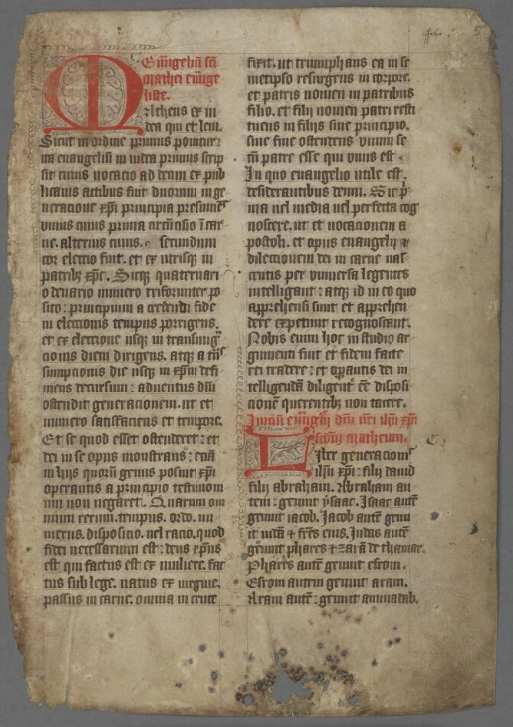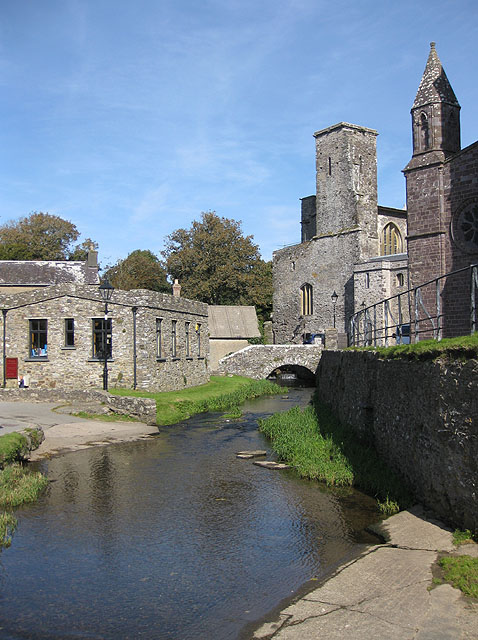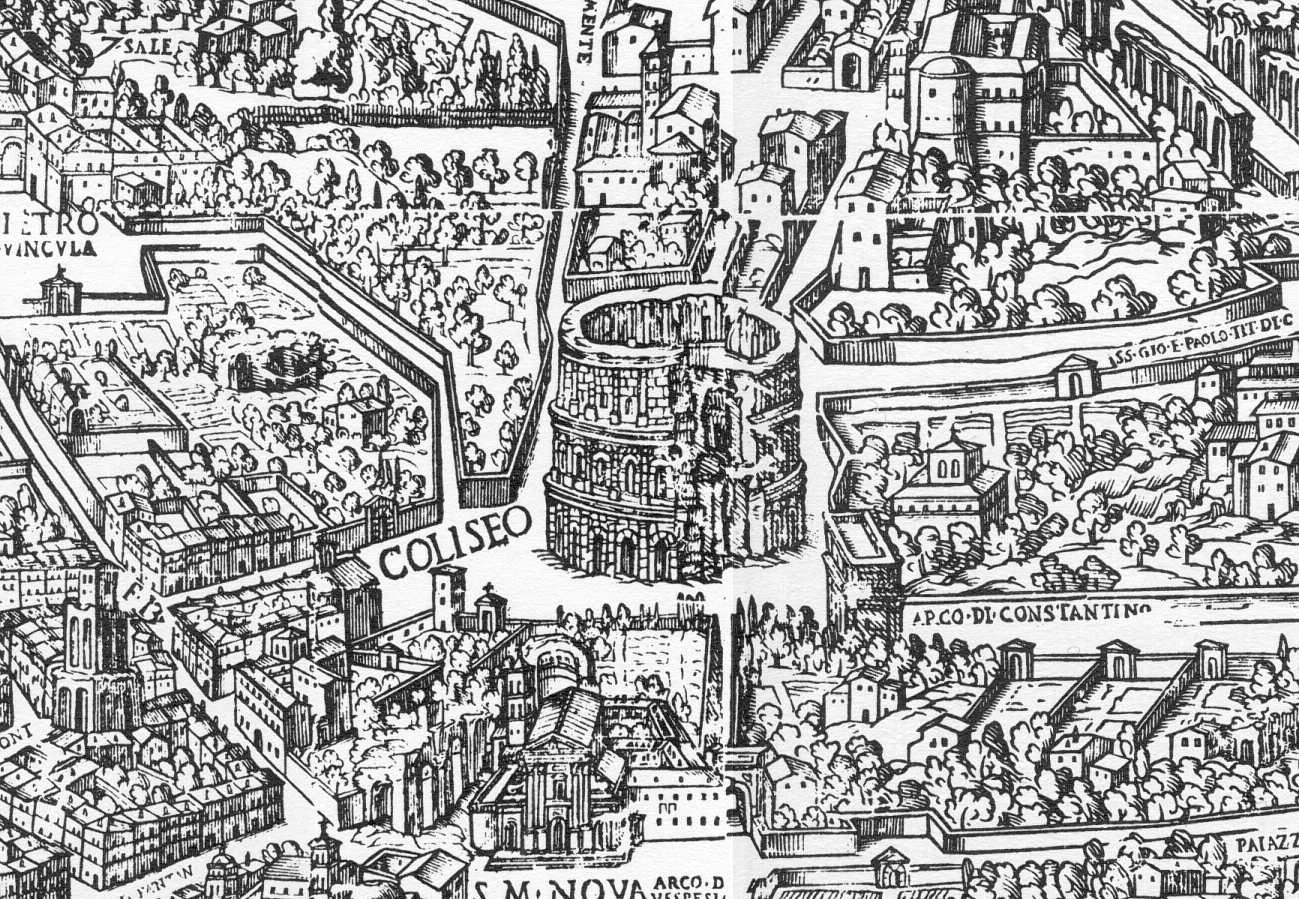|
Urban (bishop Of Llandaff)
Urban (1076 – 1134) was the first bishop of South East Wales to call himself 'bishop of Llandaff'. He was of a Welsh clerical family and his baptismal name in the Welsh language is given in charter sources as Gwrgan. He Latinised it to the papal name 'Urban'. Early career Urban came from one of the dominant Anglo-Welsh clerical dynasties of what was called in the eleventh century the diocese of Glamorgan. Two of his brothers are known: one called Caradoc the priest and the other, Gwrgan of Llancarfan. This would indicate that his family origins derived from the important clerical community of Llancarfan. The petition of the 'clergy and people' of Glamorgan in support of his election as bishop says that he had been consecrated priest in the English diocese of Worcester. This more than hints that Urban, as with several other known clerics from the southern Welsh dioceses, had been sent to England to be educated. He was already a leading cleric under his Anglo-Welsh predece ... [...More Info...] [...Related Items...] OR: [Wikipedia] [Google] [Baidu] |
Bishop Of Llandaff
The Bishop of Llandaff is the ordinary of the Church in Wales Diocese of Llandaff. Area of authority The diocese covers most of the County of Glamorgan. The bishop's seat is in the Cathedral Church of Saint Peter and Saint Paul (the site of a church traditionally said to have been founded in 560 by Saint Teilo), in the village of Llandaff, just north-west of the City of Cardiff. The bishop's residence is Llys Esgob, The Cathedral Green, Llandaff, in Cardiff. Brief history The controversial Iolo Manuscripts claim an older foundation dating to Saints Dyfan and Fagan, said elsewhere to have missionized the court of King Lucius of Britain on behalf of Pope Eleutherius around AD 166. The manuscripts—others of which are original and others now known forgeries—list Dyfan as the first bishop and, following his martyrdom, Fagan as his successor. Baring-Gould refers to them as chorepiscopi. The present-day St Fagans (referenced in the manuscripts as " ... [...More Info...] [...Related Items...] OR: [Wikipedia] [Google] [Baidu] |
St Davids
St Davids or St David's ( cy, Tyddewi, , "David's house”) is a city and a community (named St Davids and the Cathedral Close) with a cathedral in Pembrokeshire, Wales, lying on the River Alun. It is the resting place of Saint David, Wales's patron saint, and named after him. St Davids is the United Kingdom's smallest city in population (just over 1,600 in 2011) and urban area (the smallest city by local authority boundary area being the City of London). St Davids was given city status in the 12th century. This does not derive automatically from criteria, but in England and Wales it was traditionally given to cathedral towns under practices laid down in the early 1540s, when Henry VIII founded dioceses. City status was lost in 1886, but restored in 1994 at the request of Queen Elizabeth II. History Early history Although the surrounding landscape is home to a number of Palaeolithic, Bronze Age and Iron Age sites, archaeological evidence suggests that Pembrokeshire wa ... [...More Info...] [...Related Items...] OR: [Wikipedia] [Google] [Baidu] |
1134 Deaths
. Year 1134 ( MCXXXIV) was a common year starting on Monday (link will display the full calendar) of the Julian calendar. Events By place Asia * Count Hugh II (du Puiset), in alliance with the Egyptian city of Ashkelon, revolts against King Fulk V of Jerusalem, attempting to take Jaffa. Hugh submits to Fulk and is exiled for three years. While awaiting for a boat to Italy he is attacked by a Breton knight, but survives the attempted murder. Hugh retires to the Sicilian court of his cousin, King Roger II, who appoints him to the lordship of Gargano, where he dies soon afterwards. * Mas'ud becomes sultan of the Seljuk dynasty in Hamadan. * Yelü Dashi captures Balasagun from the Kara-Khanid Khanate, marking the start of the Qara Khitai empire (and its Kangguo era) in Central Asia. * Wu Ge, Chinese Song Dynasty Deputy Transport Commissioner of Zhejiang, has paddle wheel warships constructed with a total of nine wheels, and others with thirteen wheels. Europe Eastern ... [...More Info...] [...Related Items...] OR: [Wikipedia] [Google] [Baidu] |
1076 Births
Year 1076 (Roman numerals, MLXXVI) was a leap year starting on Friday (link will display the full calendar) of the Julian calendar. Events By place Europe * January 24 – Synod of Worms (1076), Synod of Worms: Emperor Henry IV, Holy Roman Emperor, Henry IV holds a synod in Worms, Germany, Worms (modern Germany). The assembly declares Pope Pope Gregory VII, Gregory VII deposed, and the bishops abandon their allegiance to him. * February 22 – Gregory VII pronounces a sentence of excommunication against Henry IV at Rome. He is excluded from the Catholic Church, and all the bishops named by Henry are excommunicated. * Summer – Dirk V, Count of Holland, Dirk V, count of County of Holland, Holland, re-conquers West Friesland (region), West Frisia (modern Netherlands) from the Roman Catholic Archdiocese of Utrecht, Archdiocese of Utrecht. He besieges Bishop Conrad (bishop of Utrecht), Conrad at the castle of IJsselmonde, Rotterdam, IJsselmonde – taking him ... [...More Info...] [...Related Items...] OR: [Wikipedia] [Google] [Baidu] |
Innocent II
Pope Innocent II ( la, Innocentius II; died 24 September 1143), born Gregorio Papareschi, was head of the Catholic Church and ruler of the Papal States from 14 February 1130 to his death in 1143. His election as pope was controversial and the first eight years of his reign were marked by a struggle for recognition against the supporters of Anacletus II. He reached an understanding with King Lothair III of Germany who supported him against Anacletus and whom he crowned as Holy Roman emperor. Innocent went on to preside over the Second Lateran council. Early years Gregorio Papareschi came from a Roman family, probably of the ''rione'' Trastevere. Formerly a Cluniac monk, he was made cardinal deacon of San Angelo in 1116 by Pope Paschal II. Gregorio was selected by Pope Callixtus II for various important and difficult missions, such as the one to Worms for the conclusion of the Concordat of Worms, the peace accord made with Holy Roman Emperor Henry V in 1122, and also the one tha ... [...More Info...] [...Related Items...] OR: [Wikipedia] [Google] [Baidu] |
Deheubarth
Deheubarth (; lit. "Right-hand Part", thus "the South") was a regional name for the realms of south Wales, particularly as opposed to Gwynedd (Latin: ''Venedotia''). It is now used as a shorthand for the various realms united under the House of Dinefwr, but that Deheubarth itself was not considered a proper kingdom on the model of Gwynedd, Powys, or Dyfed is shown by its rendering in Latin as ''dextralis pars'' or as ''Britonnes dexterales'' ("the Southern Britons") and not as a named land. In the oldest British writers, ''Deheubarth'' was used for ''all'' of modern Wales to distinguish it from ''Hen Ogledd'' (''Y Gogledd''), the northern lands whence Cunedda and the Cymry originated. History Deheubarth was united around 920 by Hywel Dda out of the territories of Seisyllwg and Dyfed, which had come into his possession. Later on, the Kingdom of Brycheiniog was also added. Caerleon was previously the principal court of the area, but Hywel's dynasty fortified and built up a new ... [...More Info...] [...Related Items...] OR: [Wikipedia] [Google] [Baidu] |
Herefordshire
Herefordshire () is a county in the West Midlands of England, governed by Herefordshire Council. It is bordered by Shropshire to the north, Worcestershire to the east, Gloucestershire to the south-east, and the Welsh counties of Monmouthshire and Powys to the west. Hereford, the county town of Herefordshire has a population of approximately 61,000, making it the largest settlement in the county. The next biggest town is Leominster and then Ross-on-Wye. The county is situated in the historic Welsh Marches, Herefordshire is one of the most rural and sparsely populated counties in England, with a population density of 82/km2 (212/sq mi), and a 2021 population of 187,100 – the fourth-smallest of any ceremonial county in England. The land use is mostly agricultural and the county is well known for its fruit and cider production, and for the Hereford cattle breed. Constitution From 1974 to 1998, Herefordshire was part of the former non-metropolitan county of Hereford and Wor ... [...More Info...] [...Related Items...] OR: [Wikipedia] [Google] [Baidu] |
Honorius II
Pope Honorius II (9 February 1060 – 13 February 1130), born Lamberto Scannabecchi,Levillain, pg. 731 was head of the Catholic Church and ruler of the Papal States from 21 December 1124 to his death in 1130. Although from a humble background, his obvious intellect and outstanding abilities saw him promoted up through the ecclesiastical hierarchy. Attached to the Frangipani family of Rome, his election as pope was contested by a rival candidate, Celestine II, and force was used to guarantee his election. Honorius's pontificate was concerned with ensuring that the privileges the Roman Catholic Church had obtained through the Concordat of Worms were preserved and, if possible, extended. He was the first pope to confirm the election of the Holy Roman emperor. Distrustful of the traditional Benedictine order, he favoured new monastic orders, such as the Augustinians and the Cistercians, and sought to exercise more control over the larger monastic centres of Monte Cassino and Cluny ... [...More Info...] [...Related Items...] OR: [Wikipedia] [Google] [Baidu] |
John Of Crema
John of Crema (Giovanni da Crema) (died before 27 January 1137) was an Italian papal legate and cardinal. He was a close supporter of Pope Callistus II. Cardinal Giovanni, the son of Olricus and Rathildis, was a native of Crema, a town 17km northeast of Lodi in Lombardy. Giovanni became Cardinal around 1116. In 1116, the Emperor Henry V had given the bishopric of Verdun to Archdeacon Henry of Winchester, who had conveyed Mathilda, daughter of the king of England, to Germany, as a reward. Archbishop Bruno of Trier disapproved of such an imperial action, and vacated the appointment; the papal legate, Archbishop Guy of Vienne, also excommunicated the emperor. On the advice of Abbot Laurentius, the emperor sent a delegation to Rome to have the excommunication voided. The embassy was captured in the neighborhood of Milan, and brought to the legate, Cardinal Giovanni of San Crisogono. Bishop-elect Henry was absolved, consecrated, and sent back to Verdun, from which he was excluded by ... [...More Info...] [...Related Items...] OR: [Wikipedia] [Google] [Baidu] |
Calixtus II
Pope Callixtus II or Callistus II ( – 13 December 1124), born Guy of Burgundy, was head of the Catholic Church and ruler of the Papal States from 1 February 1119 to his death in 1124. His pontificate was shaped by the Investiture Controversy, which he was able to settle through the Concordat of Worms in 1122. As son of Count William I of Burgundy, Guy was a member of and connected to the highest nobility in Europe. He became archbishop of Vienne and served as papal legate to France. He attended the Lateran Synod of 1112. He was elected pope at Cluny in 1119. The following year, prompted by attacks on Jews, he issued the bull ''Sicut Judaeis'' which forbade Christians, on pain of excommunication, from forcing Jews to convert, from harming them, from taking their property, from disturbing the celebration of their festivals, and from interfering with their cemeteries. In March 1123, Calixtus II convened the First Lateran Council which passed several disciplinary decrees, such as t ... [...More Info...] [...Related Items...] OR: [Wikipedia] [Google] [Baidu] |
Reims
Reims ( , , ; also spelled Rheims in English) is the most populous city in the French department of Marne, and the 12th most populous city in France. The city lies northeast of Paris on the Vesle river, a tributary of the Aisne. Founded by the Gauls, Reims became a major city in the Roman Empire. Reims later played a prominent ceremonial role in French monarchical history as the traditional site of the coronation of the kings of France. The royal anointing was performed at the Reims Cathedral, Cathedral of Reims, which housed the Holy Ampulla of chrism allegedly brought by a white dove at the baptism of Frankish king Clovis I in 496. For this reason, Reims is often referred to in French as ("the Coronation City"). Reims is recognized for the diversity of its heritage, ranging from Romanesque architecture, Romanesque to Art Deco, Art-déco. Reims Cathedral, the adjacent Palace of Tau, and the Abbey of Saint-Remi were listed together as a UNESCO World Heritage Site in 1991 ... [...More Info...] [...Related Items...] OR: [Wikipedia] [Google] [Baidu] |
Bishop Of St Davids
The Bishop of St Davids is the ordinary of the Church in Wales Diocese of St Davids. The succession of bishops stretches back to Saint David who in the 6th century established his seat in what is today the city of St Davids in Pembrokeshire, founding St Davids Cathedral. The current bishop of St Davids is Joanna Penberthy, since the confirmation on 30 November 2016 of her election.Church in Wales — Election of Wales’ first woman bishop is confirmed (Accessed 5 January 2017) History The history of the diocese of St Davids is traditionally traced to that saint in the latter half of the 6th century. Records of the history of the diocese before |






